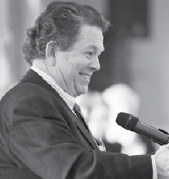 Dr. Arthur B. Laffer, internationally regarded economist and longtime consultant to investment managers and employees Caldwell Trust Company, made a special presentation on the economy to Caldwell’s board of directors and officers on March 20. Known as “The Father of Supply-Side Economics” for his influence in the tax-cutting movement under President Ronald Reagan in the 1980s, Dr. Laffer is also acclaimed as a founder of the Laffer Curve, which represents a graphic relationship between tax revenues and tax rates.In welcoming the guest speaker, R. G. “Kelly” Caldwell Jr., CEO and president, said, “We go way back together. Dr. Laffer has been vital to our company for the whole 20 years of Caldwell Trust Company’s life and we’re looking forward to a long, long relationship.”
Dr. Arthur B. Laffer, internationally regarded economist and longtime consultant to investment managers and employees Caldwell Trust Company, made a special presentation on the economy to Caldwell’s board of directors and officers on March 20. Known as “The Father of Supply-Side Economics” for his influence in the tax-cutting movement under President Ronald Reagan in the 1980s, Dr. Laffer is also acclaimed as a founder of the Laffer Curve, which represents a graphic relationship between tax revenues and tax rates.In welcoming the guest speaker, R. G. “Kelly” Caldwell Jr., CEO and president, said, “We go way back together. Dr. Laffer has been vital to our company for the whole 20 years of Caldwell Trust Company’s life and we’re looking forward to a long, long relationship.”
Combining intellect, experience and an insider’s knowledge of the world’s political and economic systems, Dr. Laffer focused on three separate but interrelated and overlapping topics: the importance of the 50 states, Crimea and economics.
The states: where the action is
“If you look at the United States, it’s amazing what’s happening. State and local politics are really critical. It’s where everything is happening, and there is a battle within states like you’ve never seen before,” Dr. Laffer said. He has focused for years on the importance of the states in influencing the federal government and national policy. “Don’t think of economics as flowing down,” he said. “It bubbles up. Without California’s Proposition 13 in 1978, there would have been no President Ronald Reagan.” He also cited the impact of other historic tax-cutting actions within states.
Dr. Laffer has analyzed numerous econometric criteria among the states and provides detailed results in his newest book, An Inquiry into the Nature and Causes of the Wealth of States (Wiley: April 2014). In the chapter titled “Fall from Grace,” he measures changes in the 11 states that have introduced a personal income tax since West Virginia took this action in 1961. He compares each state’s status four years before its income tax was instituted with its position today. The major metrics include population growth, labor force growth, employment growth, GSP and tax revenue. His conclusion: You cannot tax a state into prosperity.
Crimea: the problem is us
“Whether Crimeans are Russians who were transferred to Ukraine by the Ukrainian Nikita Khrushchev in 1954 is not the issue. Whatever the facts are, we have to realize that Putin is Putin and Russia is Russia. If an opportunity avails, they will take it. You cannot blame Putin for this. The problem is not Russia. We are the problem,” Dr. Laffer said.
Russia’s incursion into Ukraine has occurred without significant consequences from the U.S. to date. It may appear as if the underlying problem is a weak U.S. military; however, this is a symptom of the bigger issue, Laffer stated. He called it a direct result of America’s economic malaise. “You can’t have a strong country without a strong economy,” he said.
The economy and redistribution
“Every revolution ever fought on planet Earth has been based on changing the distribution of income, but no revolution has ever been able to change that distribution. What all revolutions have succeeded in doing is destroying the volume of income,” Laffer said. “In this country today, we are in the midst of a revolution to redistribute income and you are now seeing the violent consequences. Finally it comes down to situations and policies affecting labor and real output. We cannot hold back aggressor nations without a strong economy, and we cannot provide prosperity for our own citizens without a strong economy.”Laffer was emphatic about the need for action. “We have to reverse counterproductive and restrictive economic policies, and we have to do it soon,” he said.
A mirror image
“Today we have almost a mirror image of the late ’70s-early ’80s and we’re on the verge of changing direction, with a huge reversal like the one we saw in the ’80s. The other good news is that conservative economic policies are really winning big in the states. Finally, on a national level, by 2016 we will very likely get a pro-growth candidate—and it doesn’t necessarily have to be a Republican. The natural order of things is not partisan politics,” Dr. Laffer said. “We know what we have to do in order to get America strong again, and it’s really simple:
- low-rate flat tax;
- restrictions on spending;
- sound money;
- retrained workforce;
- strong military;
- minimal regulation.
“Once we accomplish these things, we’ll just need to get out of the way and let the free market create prosperity,” Dr. Laffer concluded. “The best is yet to come!”
The year to date
Our review of the year to date is in synch with Dr. Laffer’s positive outlook. As we mentioned at the start of 2014, we expect that stocks this year might take a pause in their upward march or, in relative terms, produce lower total returns than bonds. That has been the case so far and this year is a long way from being over.
The slowdown has happened against the domestic backdrop of the Federal Reserve Board’s decision to continue tapering its bond purchases and the international context of geopolitical uncertainty in Ukraine. Now we ask: where do things go from here?
Stocks have spent the first part of the year in a sideways pattern with some volatility. We would characterize the stock market as fairly valued here in the U. S., although we have found in our travels that valuation alone is not a good predictor of changes in market direction. Our objective indicators, which combine a series of other indicators, point to a continuation in the market’s upward trend. Does that mean the possibility of a steep correction has diminished? Unfortunately, no.
Moving beyond objective, fact-based data, we believe that there is a low probability of a recession despite the Fed’s recent actions. The latest Fed meeting on March 19 ended with another $10 billion reduction and a change in strategy. The Fed dropped its 6.5 percent unemployment rate threshold and removed the inflation target of 0.5 percent above the upper end of its range. What is replacing these explicit targets is a more qualitative evaluation of the economy, which includes assessments of employment, inflation and financial conditions. The new communication from the Fed points to a more forward-looking view, and we conclude that 2015 will be the year of the first interest rate increase.
On the geopolitical front, Russia has refused to leave Crimea and by all accounts has successfully annexed that part of Ukraine despite U. S. and worldwide outrage. As Dr. Laffer pointed out, the weak U. S. response resulted from our weak economy. We can expect to regain a stronger position in the world as our economy improves.









